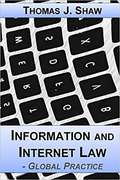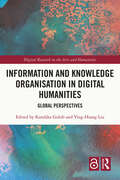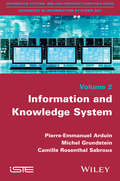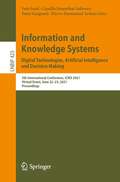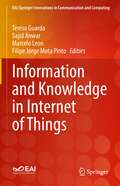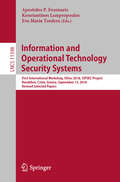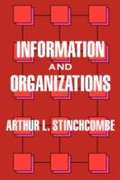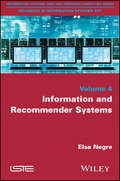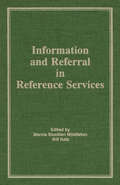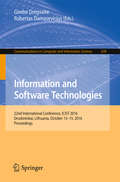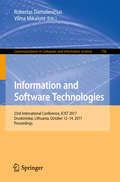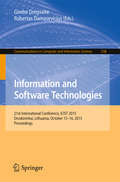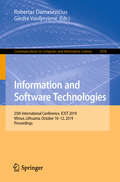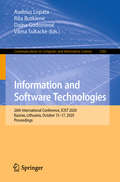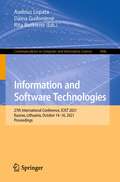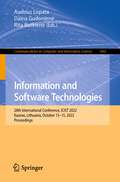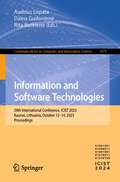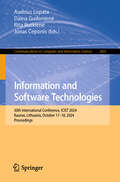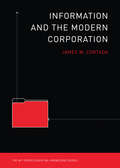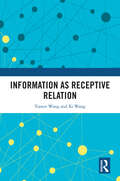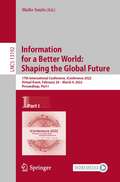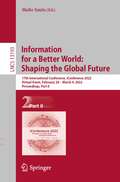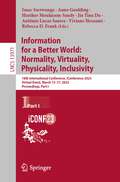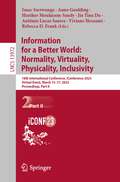- Table View
- List View
Information and Internet Law: Global Practice
by Thomas ShawThe worlds of today and tomorrow rely upon open networks connecting far-flung participants exchanging information both personal and commercial. Bringing some certainty to this very dynamic environment are the legal foundations supporting the free flow of information over the Internet. <p><p> New lawyers, lawyers new to information and Internet law, lawyers updating their knowledge on the latest statutes and cases, and lawyers desiring a global comparative legal perspective are among the audiences who require this single resource to consolidate their understanding of global information and Internet law. This book, up-to-date to March 2018, provides insight by looking at current statutes, regulations, and directives in the United States and Europe, supplemented by statutes in Asia and the Americas ex-U.S. It discusses and identifies issues raised by the latest U.S. and EU cases on protection of information and use of the Internet. <p><p> It starts with a risk-based, lifecycle approach to this area of law. The areas of information law addressed: privacy, information security, and data protection law, unlawful data disclosures through cybercrime and data breach, and lawful data disclosures related to messaging and surveillance. The areas of Internet law addressed: access, jurisdiction, speech, intermediary liability, intellectual property, and e-commerce through electronic and website agreements. Bringing a unique perspective to explain a complex topic, the author has written numerous books on legal technology and legal history, writes and speaks extensively on the latest developments in technology law, teaches U.S.-EU comparative law school courses on information, Internet, and emerging technologies law, and had worked in complementary disciplines across the major parts of the world. This book is the result of those many years of experience and insight.
Information and Knowledge Organisation in Digital Humanities: Global Perspectives (Digital Research in the Arts and Humanities)
by Koraljka Golub Ying-Hsang LiuInformation and Knowledge Organisation explores the role of knowledge organisation in the digital humanities. By focusing on how information is described, represented and organised in both research and practice, this work furthers the transdisciplinary nature of digital humanities. Including contributions from Asia, Australia, Europe, North America and the Middle East, the volume explores the potential uses of, and challenges involved in, applying the organisation of information and knowledge in the various areas of Digital Humanities. With a particular focus on the digital worlds of cultural heritage collections, the book also includes chapters that focus on machine learning, knowledge graphs, text analysis, text annotations and network analysis. Other topics covered include: semantic technologies, conceptual schemas and data augmentation, digital scholarly editing, metadata creation, browsing, visualisation and relevance ranking. Most importantly, perhaps, the book provides a starting point for discussions about the impact of information and knowledge organisation and related tools on the methodologies used in the Digital Humanities field. Information and Knowledge Organisation is intended for use by researchers, students and professionals interested in the role information and knowledge organisation plays in the Digital Humanities. It will be essential reading for those working in library and information science, computer science and across the humanities.
Information and Knowledge Organisation in Digital Humanities: Global Perspectives (Digital Research in the Arts and Humanities)
by Koraljka Golub Ying-Hsang LiuInformation and Knowledge Organisation explores the role of knowledge organisation in the digital humanities. By focusing on how information is described, represented and organised in both research and practice, this work furthers the transdisciplinary nature of digital humanities.Including contributions from Asia, Australia, Europe, North America and the Middle East, the volume explores the potential uses of, and challenges involved in, applying the organisation of information and knowledge in the various areas of Digital Humanities. With a particular focus on the digital worlds of cultural heritage collections, the book also includes chapters that focus on machine learning, knowledge graphs, text analysis, text annotations and network analysis. Other topics covered include: semantic technologies, conceptual schemas and data augmentation, digital scholarly editing, metadata creation, browsing, visualisation and relevance ranking. Most importantly, perhaps, the book provides a starting point for discussions about the impact of information and knowledge organisation and related tools on the methodologies used in the Digital Humanities field.Information and Knowledge Organisation is intended for use by researchers, students and professionals interested in the role information and knowledge organisation plays in the Digital Humanities. It will be essential reading for those working in library and information science, computer science and across the humanities. The Open Access version of this book, available at www.taylorfrancis.com, has been made available under a Creative Commons Attribution-Non Commercial-No Derivatives 4.0 license.
Information and Knowledge Systems
by Camille Rosenthal-Sabroux Michel Grundstein Pierre-Emmanuel ArduinThe purpose of this book is to question the relationships involved in decision making and the systems designed to support it: decision support systems (DSS). The focus is on how these systems are engineered; to stop and think about the questions to be asked throughout the engineering process and, in particular, about the impact designers' choices have on these systems. This therefore involves identifying the elements of the problem of decision support systems engineering: the main objects and dimensions to be considered and the relationships they involve, issues at the levels of the decision-maker, of the organization (and even of society), the general approach to which to subscribe and so on.
Information and Knowledge Systems. Digital Technologies, Artificial Intelligence and Decision Making: 5th International Conference, ICIKS 2021, Virtual Event, June 22–23, 2021, Proceedings (Lecture Notes in Business Information Processing #425)
by Camille Rosenthal-Sabroux Faiez Gargouri Pierre-Emmanuel Arduin Inès SaadThis book constitutes the thoroughly refereed proceedings of the 5th International Conference on Information and Knowledge Systems, ICIKS 2021, which was held online during June 22-23, 2021.The International Conference on Information and Knowledge Systems (ICIKS 2021) gathered both researchers and practitioners in the fields of Information Systems, Artificial Intelligence, Knowledge Management and Decision Support. ICIKS seeks to promote discussions on various organizational, technological, and socio-cultural aspects of research in the design and use of information and knowledge systems in organizations. The 10 full and 2 short papers presented in this volume were carefully reviewed and selected from 32 submissions. They were organized in topical sections as follows: knowledge systems and decision making; machine learning, recommender systems, and knowledge systems; and security, artificial intelligence, and information systems.
Information and Knowledge in Internet of Things (EAI/Springer Innovations in Communication and Computing)
by Teresa Guarda Marcelo Leon Sajid Anwar Filipe Jorge Mota PintoThis book provides readers with an insight into information and knowledge in the Internet of Things, in particular an investigation of data management and processing, information extraction, technology, knowledge management, knowledge sharing, knowledge co-creation, knowledge integration, and the development of new intelligent services available anytime, anywhere, by anyone. The authors show how IoT enables communication and ubiquitous computing between global citizens, networked machines and physical objects, providing a promising vision of the future integrating the real world of knowledge agents and things with the virtual world of information.
Information and Operational Technology Security Systems: First International Workshop, IOSec 2018, CIPSEC Project, Heraklion, Crete, Greece, September 13, 2018, Revised Selected Papers (Lecture Notes in Computer Science #11398)
by Apostolos P. Fournaris Konstantinos Lampropoulos Eva Marín TorderaThis book constitutes the refereed proceedings of the First International Workshop, IOSec 2018, sponsored by CIPSEC, held in Heraklion, Crete, Greece, in September 2018. The 12 full papers presented were carefully reviewed and selected from 22 submissions. They were organized in topical sections named: Critical Infrastructure Cybersecurity Issues; CyberSecurity Threats, Assessment and Privacy; and Vulnerability and Malware Detection.
Information and Organizations
by Arthur L. StinchcombeIn a mix of theoretical insights and anecdotal material, this book explores the ins and outs of organizations from both a macro and micro perspective that has long confronted business people and those interested in organizational theory.
Information and Recommender Systems
by Elsa NegreInformation is an element of knowledge that can be stored, processed or transmitted. It is linked to concepts of communication, data, knowledge or representation. In a context of steady increase in the mass of information it is difficult to know what information to look for and where to find them. Computer techniques exist to facilitate this research and allow relevant information extraction. Recommendation systems introduced the notions inherent to the recommendation, based, inter alia, information search, filtering, machine learning, collaborative approaches. It also deals with the assessment of such systems and has various applications.
Information and Referral in Reference Services
by Linda S KatzThis book investigates a wide variety of situations and models which fall under the umbrella of information and referral. It examines traditional views in public libraries and library systems as well as descriptions of programs in nontraditional settings, such as academic libraries. A human services perspective is explored and research models are presented.
Information and Software Technologies
by Giedre Dregvaite Robertas DamaseviciusThis book constitutes the refereed proceedings of the 20th International Conference on Information and Software Technologies, ICIST 2014, held in Druskininkai, Lithuania, in October 2014. The 34 papers presented were carefully reviewed and selected from 68 submissions. The papers are organized in topical sections such as information systems; business intelligence for information and software systems; software engineering; information technology applications.
Information and Software Technologies
by Robertas Damaševičius Vilma MikašytėThis book constitutes the refereed proceedings of the 23nd International Conference on Information and Software Technologies, ICIST 2017, held in Druskininkai, Lithuania, in October 2017.The 51 papers presented were carefully reviewed and selected from 135 submissions. The papers are organized in topical sections on information systems; business intelligence for information and software systems; software engineering; information technology applications.
Information and Software Technologies: 21st International Conference, Icist 2015, Druskininkai, Lithuania, October 15-16, 2015, Proceedings (Communications In Computer And Information Science #538)
by Giedre Dregvaite Robertas DamaseviciusThis book constitutes the refereed proceedings of the 21th International Conference on Information and Software Technologies, ICIST 2015, held in Druskininkai, Lithuania, in October 2015. The 51 papers presented were carefully reviewed and selected from 125 submissions. The papers are organized in topical sections on information systems; business intelligence for information and software systems; software engineering; information technology applications.
Information and Software Technologies: 25th International Conference, ICIST 2019, Vilnius, Lithuania, October 10–12, 2019, Proceedings (Communications in Computer and Information Science #1078)
by Robertas Damaševičius Giedrė VasiljevienėThis book constitutes the refereed proceedings of the 25th International Conference on Information and Software Technologies, ICIST 2019, held in Vilnius, Lithuania, in October 2019.The 46 papers presented were carefully reviewed and selected from 121 submissions. The papers are organized in topical sections on information systems; business intelligence for information and software systems; information technology applications; software engineering.
Information and Software Technologies: 26th International Conference, ICIST 2020, Kaunas, Lithuania, October 15–17, 2020, Proceedings (Communications in Computer and Information Science #1283)
by Audrius Lopata Rita Butkienė Daina Gudonienė Vilma SukackėThis book constitutes the refereed proceedings of the 26th International Conference on Information and Software Technologies, ICIST 2020, held in Kaunas, Lithuania, in October 2020.The 23 full papers and 7 short papers presented were carefully reviewed and selected from 78 submissions. The papers are organized in topical sections on business intelligence for information and software system; software engineering; information technology applications.
Information and Software Technologies: 27th International Conference, ICIST 2021, Kaunas, Lithuania, October 14–16, 2021, Proceedings (Communications in Computer and Information Science #1486)
by Audrius Lopata Rita Butkienė Daina GudonienėThis book constitutes the refereed proceedings of the 27th International Conference on Information and Software Technologies, ICIST 2021, held in Kaunas, Lithuania, in October 2021.The 24 full papers and 6 short papers presented were carefully reviewed and selected from 79 submissions. The papers discuss such topics as business intelligence for information and software systems, intelligent methods for data analysis and computer aided software engineering, information technology applications, smart e-learning technologies and applications, language technologies.
Information and Software Technologies: 28th International Conference, ICIST 2022, Kaunas, Lithuania, October 13–15, 2022, Proceedings (Communications in Computer and Information Science #1665)
by Audrius Lopata Rita Butkienė Daina GudonienėThis book constitutes the refereed proceedings of the 28th International Conference on Information and Software Technologies, ICIST 2022, held in Kaunas, Lithuania, in October 2022.The 23 full papers and 3 short papers presented were carefully reviewed and selected from 66 submissions. The papers discuss such topics as business intelligence for information and software systems, intelligent methods for data analysis and computer aided software engineering, information technology applications, smart e-learning technologies and applications, language technologies.
Information and Software Technologies: 29th International Conference, ICIST 2023, Kaunas, Lithuania, October 12–14, 2023, Proceedings (Communications in Computer and Information Science #1979)
by Audrius Lopata Rita Butkienė Daina GudonienėThis book constitutes the refereed proceedings of the 29th International Conference on Information and Software Technologies, ICIST 2023, held in Kaunas, Lithuania, in October 2023.The 27 full papers included in this volume were carefully reviewed and selected from 75 submissions. These proceedings contain a diverse array of research and insights in the field of Information Technology and related areas, such as: intelligent systems and software engineering advances, intelligent methods for data analysis and computer aided software engineering, language technologies and smart e-learning applications, AI-based it solutions.
Information and Software Technologies: 30th International Conference, ICIST 2024, Kaunas, Lithuania, October 17–18, 2024, Proceedings (Communications in Computer and Information Science #2401)
by Audrius Lopata Rita Butkienė Daina Gudonienė Jonas ČeponisThis book constitutes the refereed proceedings of the 30th International Conference on Information and Software Technologies, ICIST 2024, held in Kaunas, Lithuania, during October 17–18, 2024. The 25 full papers included in this book were carefully reviewed and selected from 75 submissions. They were organized in topical sections as follows: Intelligent Systems and Software Engineering Advance; Cyber Security; Intelligent Methods for Data Analysis and Computer-Aided Software Engineering; and Smart e-Learning Technologies and Applications.
Information and the Modern Corporation (The MIT Press Essential Knowledge series)
by James W. CortadaA guide to information as the transformative tool of modern business.While we have been preoccupied with the latest i-gadget from Apple and with Google's ongoing expansion, we may have missed something: the fundamental transformation of whole firms and industries into giant information-processing machines. Today, more than eighty percent of workers collect and analyze information (often in digital form) in the course of doing their jobs. This book offers a guide to the role of information in modern business, mapping the use of information within work processes and tracing flows of information across supply-chain management, product development, customer relations, and sales. The emphasis is on information itself, not on information technology. Information, overshadowed for a while by the glamour and novelty of IT, is the fundamental component of the modern corporation.In Information and the Modern Corporation, longtime IBM manager and consultant James Cortada clarifies the differences among data, facts, information, and knowledge and describes how the art of analytics has all but eliminated decision making based on gut feeling, replacing it with fact-based decisions. He describes the working style of “road warriors,” whose offices are anywhere their laptops and cell phones are and whose deep knowledge of a given topic becomes their medium of exchange.Information is the core of the modern enterprise, and the use of information defines the activities of a firm. This essential guide shows managers and employees better ways to leverage information—by design and not by accident.
Information as Receptive Relation
by Xi Wang Tianen WangThis book aims to revolutionize information research by introducing a receptive relation understanding of information, which systematically unveils its fundamental characteristics: created ex nihilo, emergence, reciprocity and shareability.Through a thorough exploration of organismic and sensory receptivity, the book establishes a mechanistic foundation for understanding the nature of information. It navigates the origins of biological information and leads readers into a new era of information studies. Offering a fresh perspective on the nature of information, it delves into its physical, digital, and ideational encodings, as well as the ideational system built upon them. The book sheds light on critical issues such as quantum manifestation of information and the fundamental laws governing the relationship between information and matter/energy. It also dispels common misconceptions about information and its role in the evolution of information civilization.The book provides valuable insights into understanding artificial general intelligence and the mysteries of consciousness and life. It will be of interest to researchers and students of information philosophy, information science, and artificial intelligence.
Information for a Better World: 17th International Conference, iConference 2022, Virtual Event, February 28 – March 4, 2022, Proceedings, Part I (Lecture Notes in Computer Science #13192)
by Malte SmitsThis two-volume set LNCS 13192 – 13193 constitutes the refereed proceedings of the 17th International Conference on Information for a Better World: Shaping the Global Future, held in February 2022. Due to COVID-19 pandemic the conference was held virtually. The 32 full papers and the 29 short papers presented in this volume were carefully reviewed and selected from 167 submissions. They cover topics such as: Library and Information Science; Information Governance and Ethics; Data Science; Human-Computer Interaction and Technology¸ Information Behaviour and Retrieval¸ Communities and Media¸ Health Informatics.
Information for a Better World: 17th International Conference, iConference 2022, Virtual Event, February 28 – March 4, 2022, Proceedings, Part II (Lecture Notes in Computer Science #13193)
by Malte SmitsThis two-volume set LNCS 13192-12193 constitutes the refereed proceedings of the 17th International Conference on Information for a Better World: Shaping the Global Future, held in February 2022. Due to COVID-19 pandemic the conference was held virtually. The 32 full papers and the 29 short papers presented in this volume were carefully reviewed and selected from 167 submissions. They cover topics such as: Library and Information Science; Information Governance and Ethics; Data Science; Human-Computer Interaction and Technology¸ Information Behaviour and Retrieval¸ Communities and Media¸ Health Informatics.
Information for a Better World: 18th International Conference, iConference 2023, Virtual Event, March 13–17, 2023, Proceedings, Part I (Lecture Notes in Computer Science #13971)
by António Lucas Soares Anne Goulding Isaac Sserwanga Heather Moulaison-Sandy Jia Tina Du Viviane Hessami Rebecca D. FrankThis two-volume set LNCS 13971 + 13972 constitutes the refereed proceedings of the 18th International Conference on Information for a Better World: Normality, Virtuality, Physicality, Inclusivity, held in March 2023.The 36 full papers and the 46 short papers presented in these proceedings were carefully reviewed and selected from 197 submissions. They cover topics such as: Archives and Records, Behavioral Research, Information Governance and Ethics, AI and Machine Learning, Data Science, Information and Digital literacy, Cultural Perspectives, Knowledge Management and Intellectual Capital, Social Media and Digital Networks, Libraries, Human-Computer Interaction and Technology, Information Retrieval, Community Informatics, and Digital Information Infrastructure.
Information for a Better World: 18th International Conference, iConference 2023, Virtual Event, March 13–17, 2023, Proceedings, Part II (Lecture Notes in Computer Science #13972)
by António Lucas Soares Anne Goulding Isaac Sserwanga Heather Moulaison-Sandy Jia Tina Du Viviane Hessami Rebecca D. FrankThis two-volume set LNCS 13971 + 13972 constitutes the refereed proceedings of the 18th International Conference on Information for a Better World: Normality, Virtuality, Physicality, Inclusivity, held in March 2023.The 36 full papers and the 46 short papers presented in these proceedings were carefully reviewed and selected from 197 submissions. They cover topics such as: Archives and Records, Behavioral Research, Information Governance and Ethics, AI and Machine Learning, Data Science, Information and Digital literacy, Cultural Perspectives, Knowledge Management and Intellectual Capital, Social Media and Digital Networks, Libraries, Human-Computer Interaction and Technology, Information Retrieval, Community Informatics, and Digital Information Infrastructure.
